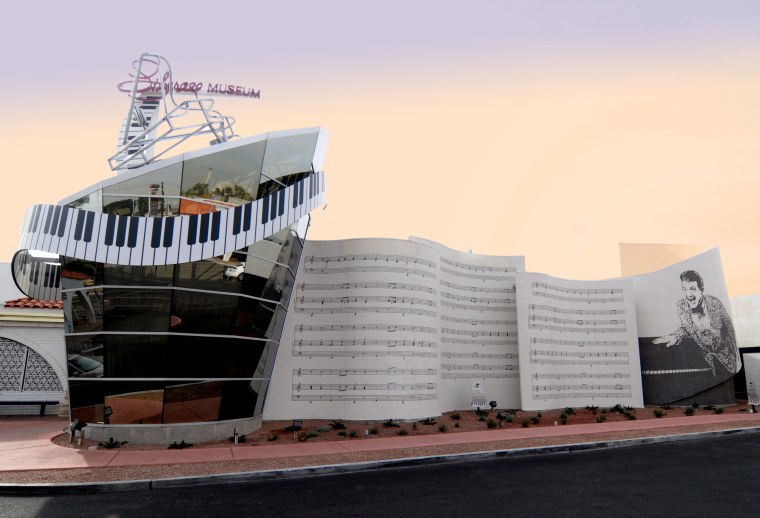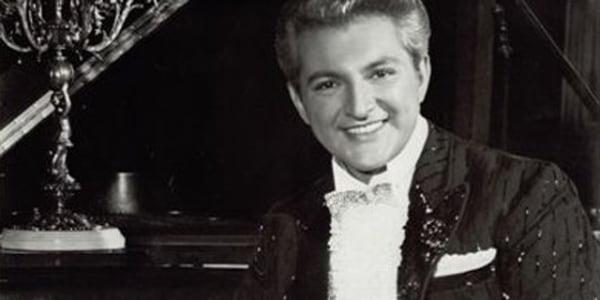The Liberace Museum in Las Vegas, honoring the flamboyant entertainer known as much for his glitzy costumes and extravagant performance style as for his piano playing, and who epitomized bling long before it was a household word, is shutting its doors on Sunday.
“In some ways, the museum was the last vestige of an entertainment icon,” said Jeff Koep, chairman of The Liberace Foundation for the Performing and Creative Arts, which runs the museum that exhibits the entertainer’s extensive costumes, cars, pianos, candelabra, and jewelry.
Often referred to as “Mr. Showmanship,” Liberace is known for giving his audience what they wanted, with performances that included everything from classical to pop music. He is credited with influencing entertainers from Elvis and Michael Jackson to Elton John and Lady Gaga.
Slideshow 9 photos
Mr. Showmanship, Liberace.
“He was Mr. Las Vegas for almost 40 years, until the year he died,” in 1987, said Darden Asbury Pyron, professor of history at Florida International University in Miami and author of “Liberace: An American Boy.” He set attendance records at Radio City Music Hall, Madison Square Garden and the Hollywood Bowl.
“It was a sell-out house, every time he went on the stage,” Pyron added. “And he was one of the first entertainers to understand the potential of television.”
The museum’s announcement in mid-September that it would end its 31-year run on Oct. 17 was unexpected, said David G. Schwartz, director of the Center for Gaming Research at the University of Nevada, Las Vegas, and in a city dominated by the casino industry, it is seen as a significant loss. “Las Vegas doesn’t have that many museums, so it’s a pretty big deal. It’s been a good thing for the city.”
“It’s been a very popular attraction,” said Alicia Malone, a public relations manager for the Las Vegas Convention and Visitors Authority. “It’s been a very unique part of Las Vegas cultural history for 31 years. That’s what visitors to Las Vegas are looking for, a one-of-a-kind experience, something you couldn’t necessarily find in other cities.”
Waning interest
Las Vegas was hard hit by the recession but tourism remained fairly strong. After decades of solid growth the number of visitors to the city dipped slightly after 2007, a record year, but in the last 11 months has either matched or surpassed monthly volume from the previous year, Malone said.
In contrast, Koep said, there has been a steady decline in numbers to the Liberace Museum, from a high of 450,000 annual visitors 15 years ago to about 50,000 annually today.
Waning interest — along with the museum’s real estate problems, mortgage debt and lack of a steady income stream — also factored into the decision to close. The Liberace Foundation owns the strip mall that houses the museum, but 50 percent of the rental units currently are vacant. And while royalty revenue from intellectual property was robust 30 years ago, today selling to a younger generation unfamiliar with Liberace’s music is tough, Koep said.
“We are not closing the book on Liberace or what he stands for,” he added. “We’re trying to regenerate the brand.”
The foundation recently finalized a deal for a national traveling tour of its Liberace collection and one day hopes to reopen the museum in a more accessible location in Las Vegas. Currently, it is five miles from the Strip.
Being more fiscally prudent also will ensure Liberace’s legacy to continue to fund scholarships. Since 1976, roughly $6 million in music scholarships have been awarded to some 2,700 students.
Several projects are in development that are not affiliated with the foundation but that could help rekindle interest in the performer. They include a musical and a Steven Soderbergh-produced movie, set to star Michael Douglas (as Liberace) and Matt Damon.
The end of an era
Wladziu Valentino Liberace, born in 1919 in Wisconsin to working class Polish-Italian immigrant parents, was a child prodigy who by age 20 had performed with the Chicago Symphony Orchestra. But he cut his classical concert pianist career short for a life in show business, adding more contemporary music to his performances.
“He didn’t find it satisfying,” said Pyron, the professor and author.
Although saddened by the museum’s closing, Pyron said “it is almost impossible for museums to be profitable enterprises.”
For some, the closing signals the end of an era.
“It’s sad. When the museum opened in 1979, there was little competition, but today there are so many other attractions on the Strip,” said Pauline Lachance, a fan since her first of some 50 concerts in 1963, and who over the years ran a couple of Liberace fan clubs, published a fan newsletter, and would decorate Liberace’s dressing room with photos framed in glitter when he came to her native Rhode Island.
“He had this very loyal following. He actually use to have lunch with some of his early fan clubs,” said Lachance, who now works as a historian at the museum. “He never lost sight of who he was, the fact that his audience made him.”
But she is hopeful for the future, noting interest in Liberace’s videos on YouTube. “He’s being discovered by a whole new generation,” she said. “He put the glitz in Las Vegas. He was so ahead of his time.”
Linda Claussen of Davenport, Iowa, a Liberace fan since 1966, said she was shocked when she heard the museum was closing.
“He was a super entertainer — his costumes, his sincerity,” said Claussen, who met Liberace four times and regularly listens to CDs and watches DVDs of his performances. “At the keyboard, there was no other match to him.
“He makes you smile and feel better about things.”

